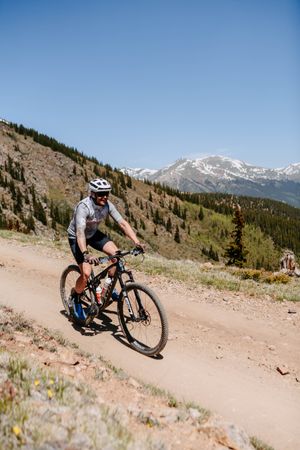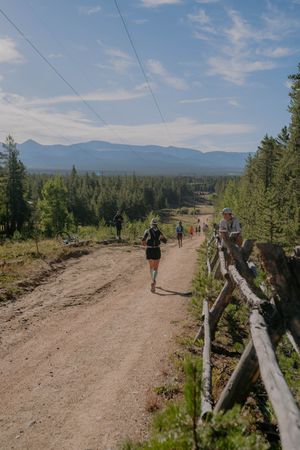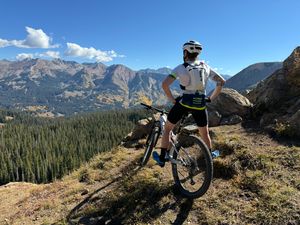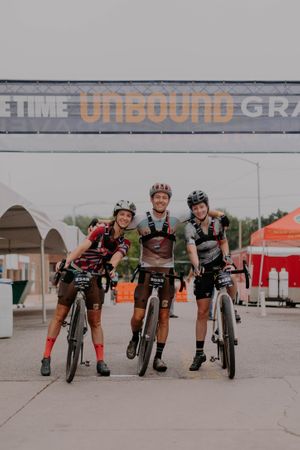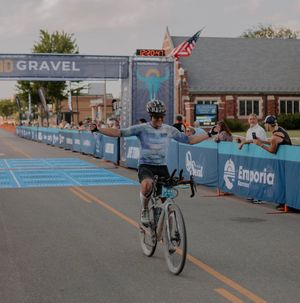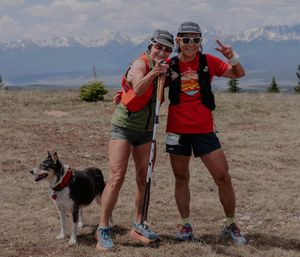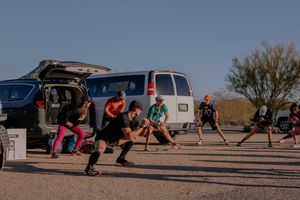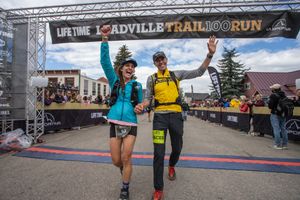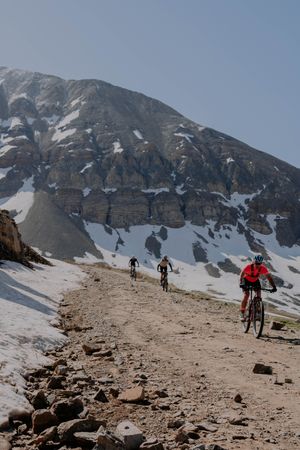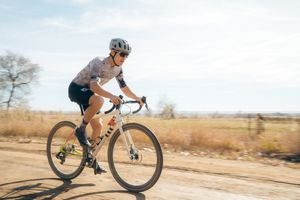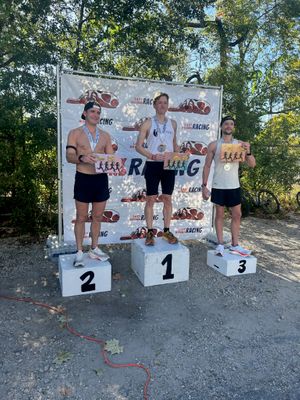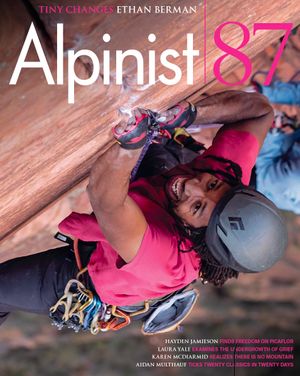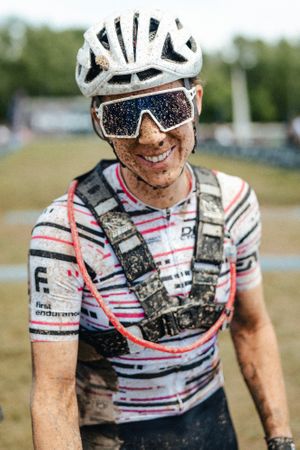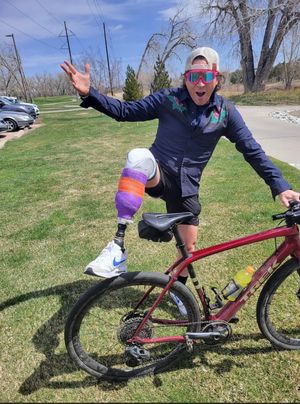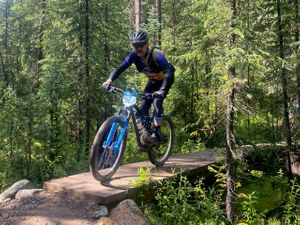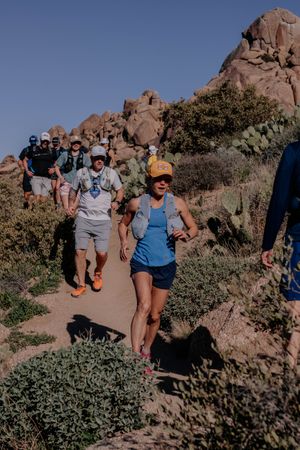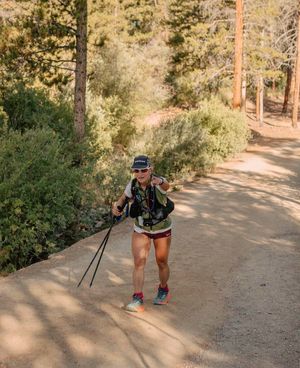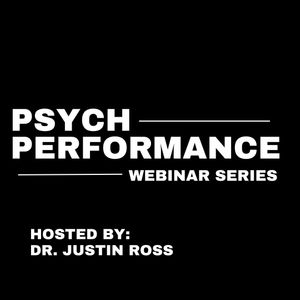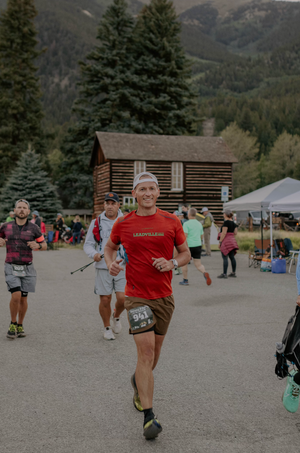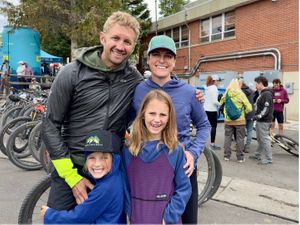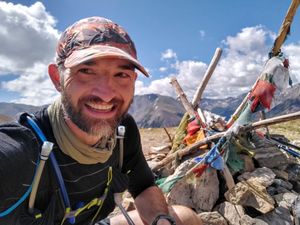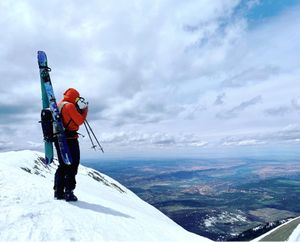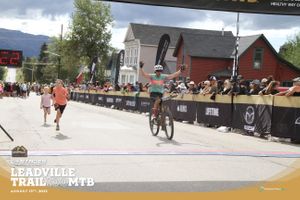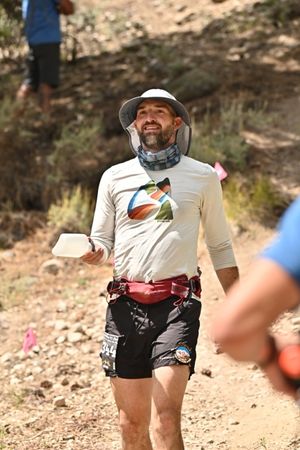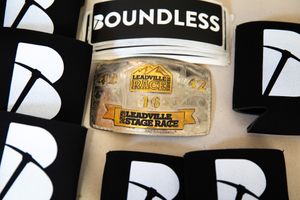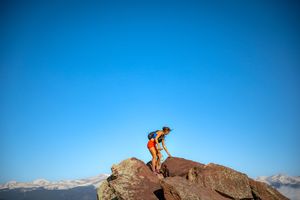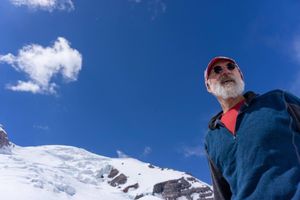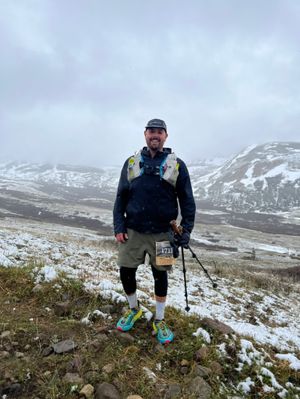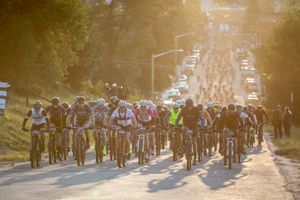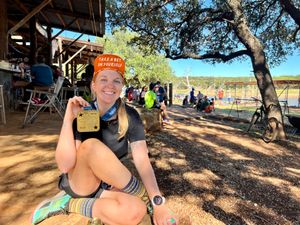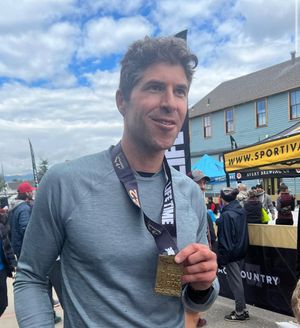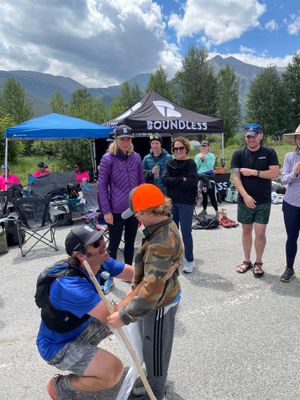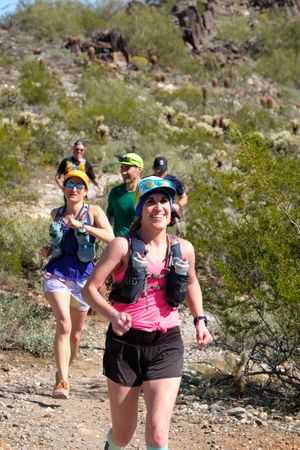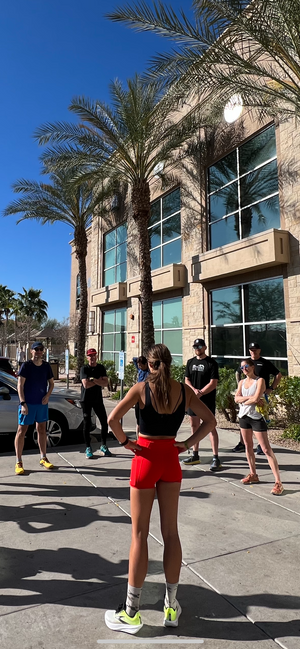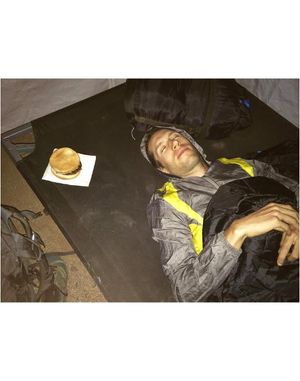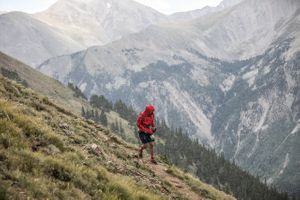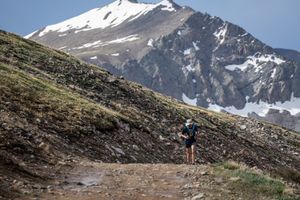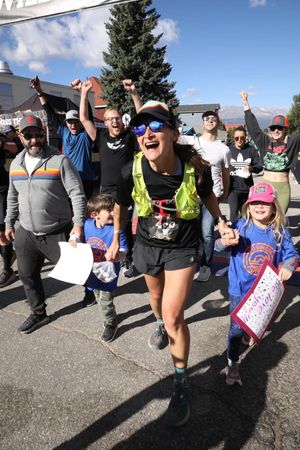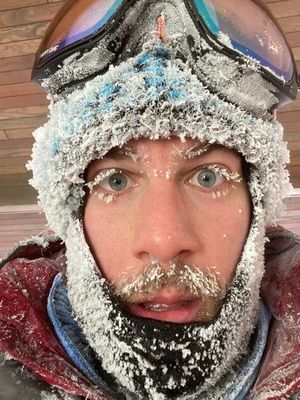Things I Wish I Knew When I Started Training & Racing Harder
Coach AJ Sobrilsky
Lessons to help you go farther, faster - and stay in the game longer
1. Recovery is Just as Important as Training
Here’s the equation I wish someone had tattooed on my forehead 15 years ago:
Stress + Rest = Growth
It’s simple, yet most of us ignore the second half. We get obsessed with the stress side (hammering workouts, racking up miles, chasing fatigue) - thinking that’s the key to getting better. But stress alone just breaks you down. Recovery is what builds you back up stronger.
Sleep, food, breathers, and true rest days aren’t optional - they’re essential. Recovery isn’t what you do when you’re too tired to train. Recovery is training.
Takeaway: If you want to go hard, you have to respect the rest. Otherwise, you’re just piling stress on a body that can’t adapt.
2. Take Your Easy Days Easy
When I first moved to Flagstaff, I thought I had to prove myself every day. Then I started doing easy runs and long efforts with some of the best runners in the world - athletes training for World Championships and Olympic team spots. And you know what shocked me?
more5 Considerations to Optimize Your Summer Training
Coach Duncan Callahan
Summer training is just around the corner, and the energy is building. For most athletes, this means open trails, longer days, and a sharper focus on big goals. But how do you make the most of it? What should you be focusing on, and what key reminders will keep you on track?
1. Understand the real time cost. As your training volume increases, it will take more out of your daily life than just the workout itself. A 3 hour long run might end up taking 6 hours of real time once you factor in planning, prep, driving, recovery, and extra eating. Knowing this helps you manage the overall stress better.
- * Bonus tip: Talk this through with your spouse and family ahead of time - it’ll go a long way.
2. Specificity still rules. In short, train on the terrain and in the conditions that you know your target race will have. This one is quite simple and very enjoyable. For most, this will mean more trail time, mountain adventures, and fueling practice. In particular, maximize specificity on your long runs. This is WHY you do what you do, so lean into it!
moreDurability: The KPI You Should Actually Care About
Coach AJ Sobrilsky
Let’s be honest—most of us mountain athletes love our numbers. FTP, VO2 max, race pace, finger strength, redpoint grades—we collect and compare these stats like Pokémon cards, hoping they’ll prove our superiority on the trail, crag, or bike. But what if I told you that your most important performance metric isn’t on your TrainingPeaks dashboard? Unpopular opinion incoming: the real KPI that determines your long-term success isn’t any of these—it’s durability.
What is Durability, and Why Should You Care?
Durability is essentially your ability to sustain a high level of performance over the long haul—both within a single effort and across an entire season (or lifetime, if we’re really thinking big picture). It’s about consistency and repeatability, not just isolated peak performances when you’re feeling fresh and tapered. Some real-world examples:
Cyclists: Holding power and hitting race-winning moves after five hours in the saddle, not just throwing down big watts in a five-minute effort when fresh.
Trail Runners: Maintaining a strong pace and fluid stride deep into an ultra, rather than just crushing the first climb and then shuffling home.
more
Mastering Gravel Skills: Handling, Cornering & Climbing Like a Pro
Gravel riding isn’t just about fitness—it’s about skill. Navigating loose terrain, handling fast descents, and tackling steep climbs all require technique and confidence. Whether you're training for Unbound Gravel, or just looking to ride smoother and stronger, these essential skills will help you conquer any course.
1. Mastering Bike Handling
Gravel roads can be unpredictable—one moment you're cruising on packed dirt, the next you're fishtailing through deep gravel. Here’s how to stay in control:
Relax Your Grip: Keep your hands light on the bars to absorb bumps rather than fight them.
Stay Loose: A rigid body makes for a rougher ride. Bend your elbows and let the bike move beneath you.
Pick a Line: Look ahead, not down. Scan for the smoothest path and avoid deep gravel pockets.
2. Cornering with Confidence
Cornering on gravel is a skill that requires practice—too much speed or the wrong line can send you sliding out. Improve your technique with these tips:
Brake Before the Turn: Scrub speed before entering the corner, not while in it.
more
Nutrition 101 for Cyclist: How to Fuel for Long Days in the Saddle
Off-road cycling isn’t just about strength and endurance—it’s about fueling smart to keep your energy high and performance strong. Whether you’re tackling rolling hills or grinding through rough terrain, your nutrition strategy will make or break your long days in the saddle. Here’s how to optimize on-bike fueling, hydration, and post-ride recovery.
On-Bike Fueling: Stay Ahead of the Bonk
Your body needs a steady supply of carbohydrates to sustain endurance efforts. Unlike shorter road rides, gravel or MTB rides often have unpredictable conditions, making consistent fueling even more critical.
Fueling Guidelines:
Eat early, eat often. Start consuming calories within the first 30 minutes of your ride.
Aim for 60-90+g of carbohydrates per hour, depending on intensity and duration.
Use a mix of fuel sources: real food (like rice cakes or bananas), bars, gels, and chews.
Don’t wait until you’re hungry—small, frequent bites every 15-20 minutes help maintain energy levels.
more
Celebrating the Women of Boundless Coaching: Here's to You!
March is Women's History Month—a time to recognize, honor, and celebrate the incredible women who make up the Boundless Coaching community. From our dedicated athletes to our inspiring coaches, the women of Boundless embody resilience, strength, and determination in every mile, climb, and finish line crossed.
A Community of Trailblazers
Boundless Coaching is more than just training—it’s a community fueled by passion, support, and a relentless pursuit of personal growth. Our female athletes and coaches bring an unshakable spirit to everything they do, pushing boundaries and setting new standards in endurance sports. Whether they’re tackling the Leadville Trail 100 Run/MTB, grinding through the grueling climbs of UNBOUND Gravel, or balancing training with the demands of everyday life, these women prove that limits are meant to be broken.
Our Coaches: Leaders, Mentors, and Game-Changers
Behind every athlete’s journey is a coach who believes in them, challenges them, and helps them reach new heights. The women on our coaching staff bring an unmatched level of expertise, compassion, and drive to the Boundless team. They know firsthand what it takes to put in the work and show up stronger every day—not just as athletes, but as mentors and leaders in the endurance community.
more3 Ways to Improve Your Climbing for the Leadville 100
The Leadville Trail 100 Run and MTB are both legendary for their high-altitude climbs, relentless elevation gain, and unforgiving terrain. Whether you’re grinding up Powerline on two feet or two wheels, or tackling Hope Pass or Columbine, one thing is certain—your ability to handle long, sustained climbs will make or break your race.
Here are three ways to improve your climbing so you can conquer Leadville with confidence:
1. Build Strength with Targeted Hill Workouts
No matter your discipline, strong climbing legs are a must. Incorporating structured workouts will help you maintain power on the ascents and stay steady over 100+ miles.
For Runners:
➝ Hill Repeats: Find a moderate incline (6-10%) and run hard uphill for 1-3 minutes, then jog back down. Repeat 6-10 times.
➝ Long, Sustained Climbs: Run at a steady aerobic effort for 20-30 minutes to simulate Leadville’s long ascents.
➝ Power Hiking Practice: Hiking efficiently on steep climbs (like Hope Pass) conserves energy and keeps you moving forward.
more3 Important Strength Exercises for Trail and Ultrarunners
Coach Lance Parker
Trail and ultrarunning demands more than just endurance—you need strength, stability, and resilience to handle steep climbs, technical descents, and long miles. Incorporating strength exercises into your training can improve performance and reduce injury risk.
Here are three essential movements to add to your routine, along with ways to progress as you get stronger:
1. Single-Leg Step-Up
Why it’s important: Trail running requires strong, stable legs for uphill climbing and maintaining control on uneven terrain. The single-leg step-up enhances leg strength, balance, and coordination—key components for powering up hills and maintaining efficiency over long distances.
How to do it:
- Find a sturdy bench or step about knee height.
- Place one foot on the step and push through your full foot to lift yourself up.
- Control the movement as you step down.
- Perform 3 sets of 10-12 reps per leg.
How to progress:
- Add weight by holding dumbbells or wearing a weighted vest.
- Slow down the movement to emphasize control and eccentric strength.
- Increase step height to challenge range of motion.
What does Leadville mean to you? The Story of the Sachs Family & the LT100 Run
Lindsey Sachs
My Leadville 100 journey began at the finish line of the Silver Rush 50 in 2014. Looking down on Dutch Hill, two thoughts came to mind. 1. Am I about to be engaged?! My favorite Keith Urban song “Somebody Like You” was ironically playing and my now husband was holding a bottle of champagne to celebrate my first 50-mile finish. 2. While scrambling to find lip gloss in case the engagement were to happen, I thought “that was SO fun; I’m not ready for the day to be over.
Although an engagement didn’t come at that moment, my quest to conquer the illustrious Leadville Trail 100 Run came on in full force. Feeling like I wanted more miles, and more of Leadville, I didn’t realize I was about to embark on a multi-year journey to join the ranks of those who experience a Leadville 100 finish line moment on 6th Street.
Finishing 100 miles is never guaranteed and although I lacked ultra experience, I’ve always tried no matter the scale of the risk vs reward. With a heavy dose of naivety, the belief that it was possible and a deep core desire to explore my boundaries with running, I found myself on a multi-year journey of 100 miles that spanned getting married and having two incredible children.
more2025 Do's and Don't's for Endurance Athletes
A new year means new opportunities to level up your endurance game! Whether you’re training for your first big race or aiming to set a PR this season, here are some essential do’s and don’ts from your Boundless Team to guide you through 2025 like a pro.
DO: Try Something New
Switch things up in 2025! Try a new race, cross-train with a new sport, or attend a new camp like our Arizona Run Camp. Exploring fresh approaches and new challenges can reignite your passion for the sport.
DON’T: Neglect Nutrition
Fueling your body properly isn’t optional—it’s essential. Don’t wait until race day to figure out your nutrition strategy; practice it during training to see what works best for you. Work with one of our Nutrition Coaches to see how prioritizing nutrition can significantly impact your performance in 2025.
DO: Prioritize Recovery
Rest days, mobility work, and sleep are your secret weapons! Incorporating recovery into your training plan will keep you strong and injury-free.
moreHow to Best Set Endurance Goals for a Successful Year?
Boundless Founder & Coach, Ryan Krol
As the new year begins, it’s the perfect time to set fresh endurance goals that will challenge and inspire you (should also scare you a little bit). Whether you're a seasoned ultra-runner, a dedicated cyclist, or just starting your fitness journey, goal-setting can transform your training and keep you motivated throughout the year. Here are some tips to help you create meaningful and achievable endurance goals:
Reflect on the Past Year
Take a moment to review your accomplishments and challenges from the past year. What went well? Where did you struggle? Understanding your strengths and areas for improvement will give you a solid foundation for setting realistic and rewarding goals.
Dream Big, but Start Small
Big goals—like completing the Heavy Half, a 100-mile bike ride, or your first triathlon—can be incredibly motivating. However, breaking them down into smaller, incremental milestones will make them less overwhelming and more achievable. For instance, if your dream is to run an ultra-marathon, start by aiming for a consistent weekly mileage or a shorter race first.
Make Your Goals SMART
moreThe Season of "Yes"
Coach Alysha Davis
Off season is the season of “Yes.” Saying “yes” to the wine, extra family time, sleeping in, going to bed early, or trying something new. Off season is not the season to lose weight or increase the volume and intensity of your training. Early in my career, I did not have a professional mindset during off season, instead, I pushed too much and did not let my body, mind, and soul heal from the previous season of racing and training.
One key fundamental to work on during off season is strength. Building a solid foundation of strength will help you stay injury free for the duration of your season, help you maintain a high volume and intensity load, and helps from peaking in fitness too early in the season. Strength can be derived from having 1-2 extra gym sessions a week, focusing on hill repeats for runners and cyclist, big gear efforts for cyclist, and other forms of cross training to help work different muscle groups than your in-season sport. Building strength and getting strong should be fun, mix it up, add weights, add reps, and try something new!
After winning the 2024 Lead Challenge, I needed a big off season. Racing the back-to-back 100s after having already raced the Leadville marathon and both 50s, my body, mind, and soul, was empty and exhausted. For my first two weeks of off season, I slept, took dog walks, and lifted. There was no running, no biking, and there was no forcing myself to do something I did not want to do. The next two weeks, I started to lightly jog and cycling while maintaining lifting an extra 2 times a week. Finally, after 4-5 weeks into off season, I started including intensity back on the run and the bike by incorporating hill repeats for running strength and big gear efforts for cycling strength.
moreWhat does Peak Performance Preparation look like?
Coach Ben Dicke
This fall one of the athletes I coach landed on the podium of the New Orleans Ultramarathon 50k with a stout time of 3:28:46.
The week prior another athlete I work with finished the Chicago Marathon just under the final six and a half hour cutoff.
At first glance, these two efforts might look like they live in completely different worlds; that the athlete on the podium prepared for the effort while the other wasn’t ready at all.
Make no mistake, these were both peak performances. Athlete two didn’t just barely complete the Chicago Marathon. He crushed it. Because he wasn’t running a marathon on fresh taper legs. Rather, this athlete had completed a 100 mile run the Sunday prior.
These were both peak performances because the approach that these two athletes apply to their training is nearly identical.
So, what does peak performance preparation look like?
Our coaching group at Boundless talks a lot about “turning workouts green.” This is in reference to the completion markers assigned by our workout platform Training Peaks.
moreAlpinist 87: "Hard to Explain" by Coach Benjamin Davis
"Hard to Explain," a fiction by Boundless Coach Ben Davis was recently highlighted in Alpinist 87. Check out Coach Ben's full short story below!
morePlanning For Fall Offseason: While Building a Base for Winter Training
How do you plan for your fall offseason to ensure you recover, recharge, and still maintain your fitness level?
Proper offseason planning is key to avoiding mental or physical burnout while laying the foundation for an even stronger winter training phase. If you’ve struggled in the past with a fall training plan, we’re here to help! Here’s a guide to planning your offseason, avoiding burnout, and building solid groundwork for winter training:
1. Focus on Upcoming Goals & Active Recovery
Before diving into any structured plan, it’s important to evaluate the past season and set new goals for the coming year.
- Did you suffer injuries or overtrain?
- What were the mental and physical challenges?
- What are your short-term goals for the offseason and your long-term goals for the year?
Setting clear, attainable goals will help you stay focused and motivated through the winter months. HOWEVER, we always encourage our athletes to push their boundaries when it comes to goal setting and to BE BOUNDLESS in their journey to the finish!
After reflecting and goal setting, the first step in any offseason plan is recovery. After months of intense training and racing, your body needs time to repair and rebuild. Skipping recovery can lead to overtraining, burnout, or injury—which prolongs your goals even further.
moreRiding for ODS: 1,100 Miles in 10 Days
Greg Wells
In the spirit of “choosing to suffer for those who don’t have the choice” – a phrase he and the team came up with during his adventure last year - Greg will be riding an astounding 1100 miles over 10 days, climbing over 40,000 feet to raise awareness and funds for Open Door Sports. The route is shown below and is from the RBC office in DC to the office in Montreal – via Toronto!
Last year, Greg battled incredible challenges such as incessant rain, killer bees and, yes, a heart condition (which we did not know about) for which he had surgery a month later! He covered over 700 miles in a week. With a new heart - in more ways than one 😉 - he thinks 50% mileage more is appropriate!
He does this so kids with special needs, like his daughter, Emory, have a chance to be on a team, meet new friends and have pride in their abilities.
He does this so teens like his daughter, Marlie, can be a part of an organization that is developing understanding, respecting difference and helping them realize that we are all more alike than we are different. Thanks to your generous donations in support of Greg's efforts, ODS was able to launch a young adult basketball program, an adapted tennis program, and an adapted yoga program for those with special needs.
moreUnbound Gravel: A Coach’s Perspective
Coach Heather Fischer
I went into the race weekend knowing it was going to take a lot out of me. Unbound is a huge event, arguably the paramount gravel race in the world. I knew being my best self as a coach, full of positive energy and calm reassurance meant I would need more energy and time for my athletes so I chose to race the 50 miler. It was really fun lining up with such an enormous field and I experienced a lot of those nervous start line feelings. I’ve raced Unbound 200 and I’ve coached the Unbound Gravel training camp. I know how unforgiving the terrain can be and how extreme the conditions can get. I have a huge respect for the Flint Hills and for those brave warriors that return to Emporia’s gauntlet year after year. As a professional cyclist I’ve raced the spring classics in Europe but Unbound is another beast entirely.
The 50 mile race did not disappoint. From the start, it was mostly single file with a few souls taking their chances off the front. The front group decisively broke away when we entered a mud section. I had always planned to shoulder my bike and run if there was anything remotely dangerous to my drive train and there we were running and laughing and slipping in the deep mud, trying to edge into the tall grass as much as possible. Those of us that dismounted and remounted quickly established a small group that worked seamlessly together all the way until the final kicker in Emporia. From there it was a long sprint to the end and I am a good sprinter.
moreHeat Management Tips for Endurance Athletes
Coach Brad & Coach Scott
Coach Brad Stahlman and Coach Scott Jordan have dialed in practical strategies to increase their performance under intense heat conditions. This summer, Coach Scott finished 1st in his AG at the Keys 50 and 3rd in his AG at Western States Endurance Run. Coach Brad crushed the South Florida weather and completed the Keys 100.
Here’s some of their best advice that has recently helped them when temperature rises:
Acclimatize to Heat Pre-Race:
Focus on adapting beforehand to hot conditions by getting proper race experience in the heat prior to your goal race. Spending time in saunas or hot yoga allows your body to properly adapt as well. Lastly, gradually increase your exposure to heat during training sessions. For example, change your training days to midday or afternoon when the temperature peaks instead of early morning or evening when possible.
Prepare with Proper Cooling Accessories:
Consider using cooling accessories like ice bandannas, frog towels, or wristbands that can be filled with ice or soaked in water. Beware and be prepped for blisters these could cause with the excess water! The best way to prepare for this is to get experience racing in the heat so you know what to do and how to fight this.
more13th LT100 MTB at "Half Horse Power"
Sam Beveridge
Dear Leadville,
As I sit in my patio chair in the deck after a long day of riding bikes, working, running kids to hockey and picking up dog poop in the yard, I begin to reflect on my life and how it aligns to the Spirit of Leadville.
Oh my sweet Leadville, we have danced 12 successful times together. Each dance was a different song, but the heart and soul that we have put out there leaves us both yearning for more!
This year marks my 13th Leadville 100 MTB race. It’s going to be awesome! This one is different. Very different! Some people opt for a single speed….. well, I decided I should do this thing one-legged or as I term it, “Half Horse Power!”
You see, I lost my leg just over 2 years ago in a hunting accident where my dog shot me! You read that right, my dog shot me.
After shooting some geese, I sent Lulu (my black lab) out on a retrieve. When she charged out of the blind, Lulu stepped on my gun discharging it into my ankle that stood 2ft away. There wasn’t much left, and as I was raced to the hospital, I basically bled to death, but nope, it didn’t happen. Doctors in Greeley, CO pumped me with 11 units of blood and worked on saving me and what was left of my foot for 8hrs. I was then put in a coma to allow the team to rest and decide what my fate was the next day.
moreRiding Against the Odds: Training for Leadville 100 and Recovering from a TBI
Dean Lampe
I am not a lifelong athlete. I don’t have athletic DNA. I’m 55 years old, live at sea level in a state whose biggest climbs are the overpasses and I’m 6’2/ 190 pounds. I realize this is not the ideal scenario for racing mountain bikes in the Rockies. I’m just a guy off the couch who believes you can achieve remarkable things if you truly believe in yourself, surround yourself with the right people and commit to the goal.
Sounds really inspiring, right? Well on February 18, 2023, while pre-running an XC course, I misjudged a feature on the course and found myself on the ground in tremendous back pain, unable to get up on my own. I couldn’t help but think of the potential permanent damage. I could wiggle my toes and my fingers so I figured I was okay but the look on the face of my riding buddy, Joe Frost, was less than comforting. The paramedics got me out of the woods and rushed me to the trauma unit at my local hospital. I had broken 4 vertebrae, 6 broken ribs, damaged both shoulders and had quite a bit of soft tissue damage. That was the end of the season for me.
After a long recovery and some time off, I was back on the bike last fall. Joe and I had planned to race the Breck Epic in ’22 but Joe came down with Covid the week before the race and couldn’t compete so we decided to set our sights on the Leadville Trail 100 MTB in 2024. I was looking for ways to be more competitive, be healthier and more fit. In October I visited the Aviv Clinic for healthy aging. Outside of Dubai and Israel, the only other location happened to be close to home in central Florida. The initial visit with the team is free so I thought I would see what they had to say. I was convinced, after my initial visit that they had something unique to offer. During my pre-assessment, they found a brain injury, “diminished uptake to my right parietal lobes that was moderately severe”. I didn’t know exactly want that meant but it didn’t sound good. A traumatic brain injury (TBI) can cause many different problems and there isn’t always an easy solution. Although there is no way to know for sure, we think that this injury likely came from the 2/23 crash.
moreWhen Your Story is a Heading
Madie Dittrich
I am writing my story to inspire the heck out of every athlete who is trying to overcome an injury because injuries do happen, and we all fear it can destroy our hard work and dreams.
Seven years ago, on a different continent and hemisphere an armed robber pushed a gun to my leg and pulled the trigger. I had just returned home from competing in my third Ironman, feeling strong and probably in the best shape of my life. As good endings go, my fitness and strength saved my life. The bullet severed my femoral artery, shattered my femur, and disintegrated a section of my quadricep, leaving me with severe nerve damage.
Fast forward one year and 8 surgeries later, I found myself in the USA with a dream to do what I love: train, swim, bike, but most of all run.
That dream came to fruition when I was asked to jump in last minute as a pacer (not competitor yet) for the Leadville 100. I can still remember the inspirational talk by Ken and Marilee on August 18th 2023, the day before the race kicked off. All I could think was, “I’m in Leadville! On top of the world! I can be part of it! I can help! But most importantly, I can run!”
The journey to regaining my running abilities was not a solitary one. I had new friends make me run behind them to lose my limp and retain rhythm in my run. My CrossFit turned personal coach who to this day give me a pause when I hurt so bad that I want to throw up in my mouth.
moreLeading Women of Leadville: Coco's Inspiring Journey to a Leadville Legend
Coco Dughi
I have always been a runner. Running is existential for me; it is where I feel most alive. By the same token, I have always enjoyed spending long days in nature. Growing up in Hawaii, I spent long days hiking and surfing. Since in Colorado, I have relished spending long days hiking in the mountains, especially at altitude above the tree line.
For most of my adult life, I have been a road runner. In my late 40s and early 50s, still primarily a road runner, I would jump in the Leadville Heavy Half for the pure joy of doing a 13er with aid stations. I had a blast – running it in road shoes. Then one day, Melody Fairchild asked me to be one of her Pacers for the LT100. Her attempt never came to fruition because she became pregnant. But it was during the build up for that project that I just fell in love with the town of Leadville, Colorado and the surrounding mountains and trails. So I decided to do the Silver Rush the next year (2017)... And that was the experience that opened this new chapter in my life.
moreAnnouncing: Psych performance WEBINAR SERIES
Hosted by Dr. Justin Ross
You'll learn a range of topics, from mindset training and mental toughness, to the importance of learning both Persist and Resist mental strategies. If you're looking to perform at your peak this season, this webinar series is a tremendous value add.
moreI'm So Busy! How Do I Train for an Ultra?
By Brad Stahlman
This is a question I frequently get: With a large family, a full-time job, and countless other commitments, how do I find time to train for ultras and coach other athletes? The first answer is simply, "That's who I am," but clearly, there's more to unpack.
At the highest level, you must understand your life priorities, guiding principles, or simply your "why." My personal priorities are Faith, Family, Fitness, and Fellowship. These priorities ensure that at every decision, I'm reminded of what is important to me and strive to make those decisions in a way that supports that version of myself.
Keep in mind your priorities are likely different from mine but allow me to illustrate how my priorities align with my life.
moreThe Art of Finding Balance in Training
By Derek Murrow
As I get older, I have a greater perspective on the number of commitments that make up the majority of my daily life. Like most athletes that I coach, I work hard to juggle a demanding work schedule (outside of coaching), family activities, kids schedules, home projects (I still need to make time to take down the Clark Griswold style Christmas lights from this past holiday season), planning healthy meals, spending time with friends, making time for one on one time with my wife, walking the dog, cleaning the house, putting my girls to bed, focusing on my faith, and of course squeezing in consistent training.
If viewed at a macro level, the enormity of tasks on any given day can seem overwhelming. My goal is to break down my priorities and ruthlessly prioritize my time in areas that I have decided deserve my focus and attention. I work my athletes on creating a similar system that works within the framework of their goals and lives.
moreHow to Start Your Year off on a Healthy Note?
Ben Dicke
Many people view the new year as a chance to set new goals and create positive changes. What is the key ingredient to creating positive changes in our lives? Consistency. How do you maintain a consistent approach to training not just in January but throughout the entire year? Three things to consider: giving yourself a period of reflection, setting realistic goals, and identifying accountability partners.
Period of Reflection
The holiday season is a time of gift giving for most of us and one of the greatest gifts you can give yourself is a period of honest reflection. Taking the time to analyze your past year is the first crucial step in helping you structure your approach to the year ahead.
This reflective process should first begin on a positive note with an identification of the year’s successes. Did you run some races this year? What were the outcomes? Where was the improvement? Pull up the results pages for that 5k you forgot you ran last March. Whether or not you set a PR, relish in the fact that you got out there and put in some work. If you use an online tool to track your training, pull up your year’s stats and identify where you felt good and put in some solid training.
moreHelpful Tips to Navigating the Off-Season: A Guide for Boundless Athletes
Derek Murrow
As the chill of winter descends upon the mountains, cycling endurance athletes often find themselves transitioning into the off-season, a period often overlooked but critical for long-term success. While the temptation to lose a bit of focus, indulge at holiday gatherings, and to hibernate from training may be strong, this key downtime can be used as a golden opportunity.
At Boundless Coaching, we coach our athletes to embrace the seasonality of training and use the winter months to recharge, set new goals, and explore alternative training modalities. This proven approach helps keep the fire of motivation burning bright during the holiday season and into the 2024 season.
The off-season marks the perfect time for athletes to reflect on their achievements from the previous year and set new goals for the upcoming season. Whether it's conquering a new race or mastering an existing race, establishing clear objectives provides a roadmap for progress and keeps the flame of motivation alive. We recommend that our athletes reach for a goal that seems slightly out of reach, but within reason with proper training and motivation.
Variety is the spice of life, and the same holds true for training. Break the monotony by exploring different modalities like trail running, cross-country skiing, ski touring, and snowshoeing, and fat biking. Embracing adverse weather conditions not only enhances physical resilience but also fortifies mental toughness—a crucial asset for any endurance athlete.
moreHow to Begin Training the Mental Side of Sport in the Off-Season
Dr Justin Ross
You work hard. You train your body. You’re disciplined and committed to improving your fitness. You follow a plan for getting stronger and faster and you push yourself towards goals that matter. In your life of being an athlete, one important element may be getting left behind, however. Your mind. Sure, we’ve all been hearing so much about sports psychology and how important things like “mental toughness” and “grit” are in reaching peak performance. But has anyone ever structured a training plan for your mind in a similar fashion for how you train your body? I’m here to change that. Here’s how we get started.
How to Begin Training the Mental Side of Sport in the Offseason:
Whatever you call this time of year—the offseason, winter training, or the base-building phase—it’s an excellent opportunity to develop a strong foundation for a high-performance mindset that will carry you through the entire upcoming season. With winter's focus on building a strong aerobic foundation physiologically, it also can be an amazing time of year to lay a similarly strong foundation for your psychological development, recognizing this as a critical factor in your ability to train and race well. After all, mental strength sits at the very center of the Leadville credo that we’ve all come to love and appreciate: “Guts, Grit, and Determination,” each being a highly trainable skill. You have to earn the right to say to yourself, “I can do hard things” by how you show up daily in training. There’s no better time to begin this process than right now.
moreCoach Ben Dicke Conquering the Wasatch 100 & Leadville 100 Back to Back
Ben Dicke
Climbing up the first major ascent of the Wasatch Front 100, my legs were already tired. We were less than seven miles into the day, which at Wasatch meant at least 27 more hours of work. I knew my mental game was the only thing that would reliably keep me moving forward.
Nine months earlier I had gotten the incredible news that my name was drawn in the Leadville Trail 100 lottery. Leadville is my absolute favorite race and I had waited five years to toe the line again. This would be my fourth Leadville and I planned to focus my entire year on the training.
I laughed out loud when just three weeks later I opened an email from the Wasatch race committee alerting me that my name had been drawn in that lottery as well. "That's a tight turnaround," I said looking at the dates: August 19, Leadville, September 8, Wasatch Front. Oh well. Leadville was still my goal race, which meant a deliberate choice to not save anything for Wasatch.
My mantra for this year’s Leadville was “Stay in it.” The race is so special to me that even though this may have been the toughest conditions on that course, finishing was the only outcome I allowed myself.
moreWhy Do You Need a Training Plan for the Leadville 100?
Before working with Boundless, I didn't think a strategic training plan was necessary to accomplish my running goals. I am not a pro-runner. I am just a guy who loves to test myself against mountain courses and improve on what I have done in the past. But through working with a Boundles coach, I learned that in order to maximize my potential, my training needed to be intentional.
In high school, I was taught to always push myself; to go harder, and to dig deeper. A running mentor once told me that if everyone else was giving 100%, I needed to give 110% in every run to become stronger and faster than them. Boy, was I wrong! Turns out it is impossible to give 110%. Pushing hard on my everyday easy runs felt good and intuitive, but it led me to injury and a plateau in training performance.
When it comes to training for any long-distance race, strategy is everything. How do you build endurance; train your cardiovascular and musculoskeletal systems in unison, making sure that you are not only able to go the distance on race day, but also crush your goals while feeling good?
To build up your endurance while keeping your body healthy enough to withstand the next big stress, you must calculate each stress you put your body through, how to promote recovery from that stress, and utilize the fitness that recovery induces. It is very calculated, and it is not a “give 100% all the time” approach. Instead, it takes painstakingly building up the distance, slowly but surely. One step at a time, day in and day out. It seemed like a no-brainer. Easier said than executed!
moreAltitude Training Tips
Did you know, at 14,000 ft the air has 43% less oxygen than at sea level!?
So how do we train for Altitude?
Here’s a few tips:
1. Gradual Acclimatization: it's crucial to gradually acclimatize your body to the reduced oxygen levels. Start by training at moderate altitudes and gradually increase the elevation over time. This allows your body to adapt and build red blood cells, which carry oxygen more efficiently. Rapidly ascending to extreme altitudes increases the risk of altitude sickness.
2. You burn more energy at high altitudes. The exact increase in energy expenditure can vary depending on factors such as altitude, individual fitness level, exercise intensity, and duration. However, several studies have found that the increased energy expenditure at high altitudes can range from 10% to 30% higher compared to sea level. Bring plenty of snacks. Hydrate adequately before, during, and after exercise to counteract the dryness at elevation. Did we mention bringing PLENTY of snacks?
3. Optimal Recovery at Lower Altitudes: While high-altitude training can offer significant benefits for endurance sports, recovery at lower altitudes is optimal. When you descend to lower elevations, the increased oxygen availability allows for more efficient recovery and replenishment of energy stores. Take advantage of lower altitudes for rest days or active recovery sessions to promote muscle repair, reduce fatigue, and maximize your overall training effectiveness.
moreLife-Changing Events Leading to Big Mountains
David Tucker
11 January 2011, I had a life-changing event at age 52. I had a nearly fatal heart attack with a right coronary artery that was 100% blocked. When the doctors put in a stint and cleared the blockage, my heart stopped. The staff made me ride the lightning twice before God decided to let my heart restart. I didn’t have a cardiologist at the time, because just 6 months prior I had a physical and was given a “your good to go” diagnosis. The cardiologist that found me is a very active mountaineer (kinda weird he’s in desert of West Texas). He told me I didn’t have any sufficient heart damage and if I change couple of things, I would see a full recovery. Then, he said “sadly the majority of my patients do pretty good for five years or so then they are right back here”. Doc didn’t know it, but he threw down the gauntlet! I decided "that ain’t gonna be me”! I started eating better and exercising regularly. My 60th birthday was rolling around and I told my Flight Paramedic son who is in Alaska I wanted to do something cool for my 60th trip around the sun. He suggested he and a good friend guide me up Mt. Rainier in Washington State. Now, being a desert dweller in West Texas and training for a mountain like Rainer is a little challenging. My training consisted of carrying around and 48lb pack, wearing a climbing harness with a 25-foot 3/8” log chain tied to it slogging through the sand. Not very scientific but it worked!! Memorial Day 2018 we did summit Mt. Rainer!
moreMental Training for Endurance Athletes
Ben Davis Navy SEAL veteran and coach
Ben Davis is a Navy SEAL Veteran and CFO of Veteran's Outdoor Advocacy Group (V.O.A.G)
Growing up in Virginia, Ben developed a passion for endurance sport and mountain sports early in life. After attending college at the University of Tennessee at Chattanooga, Ben enlisted in the Navy serving in the SEAL teams. During his service he completed 3 deployments and an MBA from William and Mary. Ben has achieved and volunteered in numerous successful racing and mountaineering endeavors in the later years of his service. In the years since leaving the Navy, Ben has been a mentor and thought leader when it comes to helping individuals navigate their relationship with work, health and fitness. Currently residing in Golden CO
Race Resume:
- The Leadville Trail 100 MTB, sub 9 hours
- The Grand Traverse SKI
- Shenandoah 100 MTB
moreStarting of an Ultra Running Career
Dylan Poley
I started running consistently back in 2018. I completed a few marathons and half marathons but wanted a bigger challenge, so I set my sights on Ultras, specifically the Leadville 100 Trail Race Across The Sky.
Why Leadville?
Im not sure I can give a clear reason other than it's calling my name. It's turned into something I MUST do.
I must complete this race.
I finished the Leadville Heavy Half this past Saturday and completed it in 4 hours and 7 minutes. This was my first taste of running at elevation, and I did pretty damn well, being my first time running that distance in the mountains. This race solidified my dream of completing the Leadville 100 and gave me the extra boost and confidence moving forward as I train for next year's race across the sky.
My experience thus far training for this race with Boundless Endurance has been fantastic. My coach Zack Russell has been very supportive and knowledgeable given my young ultra-running career. The training is challenging, and I can clearly tell that it is working as I am progressing steadily.
I look forward to my next big race, the Hennepin 50 miler, in October!
-Dylan Poley
Find Dylan on Instagram: https://www.instagram.com/run_daddi/
moreStage running the Appalachian Trail and dropping the lone wolf mentality!
Christina Jax
An Accidental Shift?
Stage running the Appalachian Trail and dropping the lone wolf mentality!
This past winter, I was visiting my son at college in Phoenix. About a month before I went, I was mindlessly scrolling Instagram and happened to see a post by Boundless Endurance that it was the last day to sign up for their Arizona Running Camp. It happened to be the following weekend of visiting my son, so I thought, huh! Why not sign up and kick-start some spring training on the glorious desert trails?
I arrived at camp not realizing that this was a group of runners who were working with Boundless Endurance coaches. Many who have known each other from prior races and years on the trails. I had started following Boundless on social media after running the Leadville Heavy Half the past two years. I had seen their information while in at the races but did not have a coach or really a clue what this was all about. I had been a runner my whole life, but often trained like a lone wolf. Doing races with friends and run groups from time to time, but nothing real organized and certainly not following a disciplined coach approach.
moreLong Distance Racing: An Exercise in Variable Management
Navy SEAL veteran and Boundless Coach Ben Davis
What separates successful and unsuccessful race results can almost always be attributed to a racers ability to manage variables. In long distance bike racing, managing variables begins months or sometimes years before lining up at the start line. While physical preparedness is perhaps the most important variable, what we encounter on race day, and the way we respond is perhaps just as likely to impact how we finish the race.
My approach to managing variables has been to define those which I have total control over those which I do not. What’s critical however, is that even for those which we cannot completely control, we control the way in which we respond. We can’t control the weather on race day, but we can control how prepared we are to deal with weather. We can’t control the other riders on the course, but we can control how we will react to other riders.
Despite what many claim, the list of variables we do control, or at the very least impact, is much longer than the list of ones we cannot. One strategy I’ve developed in the days prior to an “A race”, is to control what I can control to the greatest extent possible, down to the last detail. So far this has resulted in two outcomes 1.) My race morning Is free of stress. I arrive at the race confident that both my bike, my gear, and my pre-race nutrition is ready 2.) I have a clear thought-out response to every circumstance and variable that might present itself (mechanicals, rain, hydration, etc.)
moreJordan Scales' "All-In" Introduction To Ultra Running
Jordan Scales
“It’s going to be hard work, but we'll have fun.” The last words of the first phone call with my coach. It was the end of August and I was going to run the Austin Rattler 50K in November. I had my work cut out for me. Just to spice things up a bit, I had also signed up for Brazos Bend 100 in December. Yeah, you read that right. The month right after the 50K, 28 days to be exact, I was going to tackle my first hundred.
You might be thinking to yourself that I’m overly ambitious and tad insane, and you’d be right, but that little bit of doubt from others was fuel to the fire. When I started with Boundless and Coach Scott Jordan, I needed some serious help. I was burnt out, running when I felt like it but I never really “felt like it”. I had a few marathons under my belt but I was craving more. I wanted to dig deeper, go farther, have confidence on the trails and be part of the trail running world.
After starting with Boundless I finally had a game plan. I had scheduled workouts and runs, someone keeping tabs on me and I was not about to skip or slack on anything. Running had become fun again. Running for a time period and not miles switched something in my brain that I needed. Suddenly my runs weren’t as daunting and by the end of the week my mileage was beyond anything I had done before. My body, though sore, was still going strong. It wasn’t all sunshine and rainbows, some days just sucked really hard, but there was something in the hard days and suffering that made the good days better. Definitely type two fun.
more“How to receive coaching, and reach your goals at the Leadville 100”
Written by Carson Magoon
Chris Barnett had run one ultra on a track previous to the Leadville 100. A 40 miler to raise money for charity. He was inspired to run Leadville even though he didn’t do any research about the race, and had no idea what he was getting into. He signed up for the Boundless coaching package with guaranteed entry, and was reffered to coach Cat Bradley by a friend. In the first couple of conversations, they both realized that he was in over his head. He had never heard of a pacer, didn’t realize it was on trails, and had no expereince with the details of ultra running including nutrition, night-running, or pacing. He was running all of his miles on the treadmill, too quickly, and didnt have any sort of strategy. In the first couple of months, there was friction in this new coaching relationship because he knew how to run, and therefore, thought he knew how to train for an ultramarathon. This made it hard for him accept Cat’s expertise.
When training for a 100 mile race, every run must be intentional. In early March, Cat had a hard conversation with Chris about why he wasn’t improving and was always close to injury. This heart-to-heart ended with Cat telling him the honest truth: “you’re not gonna finish Leadville if you continue training recklessly and without intention.” That was the moment Chris decided to turn it around.
moreCrewing and Pacing Presentation
Coach Jay Friedman MD and Kathy Pidcock
Join Boundless Coaches Jay Friedman MD and Kathy Pidcock as they cover the following:
- Pacing and Crewing basics
- How to Pace
- What to Expect
- Logistics
- Safety
- Gear
- Crew and Aid Stations
Leadville Ready- Nutrition for Endurance Athletes
Coach Jon Clinthorne PhD
Jonathan (Jon) Clinthorne is an ultra endurance athlete with a doctorate in Human Nutrition from Michigan State University. Growing up as a competitive swimmer, the idea of training for 2 hours a day when training for ultramarathons did not seem outlandish, so he jumped right in. During college he decided to pursue nutrition as a full-time career, falling in love with the biochemistry of ultra endurance athletics. He has run over 50 ultramarathons, including twelve 100 mile races. Jon has self-experimented with just about every nutrition approach and over the years found what works and doesn’t work. He specializes in evidenced based nutrition counseling that is combined with his deep practical knowledge of sport. His philosophy is that there is no “one size fits-all” approach to endurance nutrition and instead prefers to work with his clients to determine which evidence-based approach will fit them best. He serves on the Board of Directors along with being the Course Director for the High Lonesome 100. When not running you can find Jon skiing or hiking in the mountains of Colorado.
Specialties:
• Nutrition Counseling
• Ultramarathon
• Marathon
• Half Marathon
moreAre You Ready for Leadville? Racing at Altitude with Jay Friedman MD
Jay Friedman MD presented by The FEED
As a physiologist and physician, I believe in integrating the scientific aspects of training with the joy and appreciation for the sport I’ve gained over thirty years of running and racing on trails, roads, and track. My goal is to help build a varied, sensible training plan that fits into your busy lifestyle, and will help you reach the finish line happy, healthy, and enthusiastic for whatever challenges lie ahead.
- Education & Certifications
- Physician and Physiologist
- USATF 1
Background:
• Ultra Distance/Trail Runner/Road Racing/Exercise Physiology
Philosophy:
• Integrating scientific aspects of training toward the achievement of your goals
Race Resume:
- USATF National Champion (40-44), 100K Trail
- Top-10 finishes at national championships at 50K, 50M, 100K, 100M, and 24 hours
- “Big Buckle” at 2018 Leadville 100 in 22:40
- Over forty ultramarathon finishes
- Two-time finalist for RunUltra Blogger of the Year
moreMind over miles
Coach Jill Becker
We all have been dealt an injury,nag,surgery or setback in some shape or form throughout our life. I had a freak accident that cut my Achilles tendon at a young age that shaped my path to the Leadville race series. The one thing that has got me where I am today is my mindset.
Whether you are racing one of the Leadville race series races or preparing for another race. Some of the key ingredients to getting to that finish line is listening to your body throughout your training cycles. Keeping your easy days easy and your hard days hard. Addressing, strengthening, and stretching the areas of our body that are causing the issues. Most common injuries stem from the feet and hips and being on a structured strength and stability program will help keep you on track toward your goals. Doing periodic form checks throughout your run can also prevent injuries by addressing the issue before it becomes a recurring habit.
Whether in training, racing or throughout your day no matter if you are sidelined due to an injury or not, staying grateful and present can help keep you moving forward. Keep showing up daily and focusing on the things you can control: Your attitude and effort.
moreNutrition for Endurance Sports
Jon Clinthorne PhD
About the Event
2022 Life Time Foundation Athletes are invited to join Boundless coach Jon Clinthorne for a 30-minute presentation on nutrition for endurance athletes. Topics will include both training nutrition, i.e. what to eat over the long haul to get your body in shape, as well as performance nutrition, i.e. what do eat immediately prior to and during ultra distance events. Expect a 15-minute presentation, followed by a 15 minutes question and answer period.
About Jon
Jonathan (Jon) Clinthorne is an ultraendurance athlete with a doctorate in Human Nutrition from Michigan State University. Growing up as a competitive swimmer, the idea of training for 2 hours a day when training for ultramarathons did not seem outlandish, so he jumped right in. During college he decided to pursue nutrition as a full-time career, falling in love with the biochemistry of ultraendurance athletics. He has run over 50 ultramarathons, including twelve 100 mile races. Jon has self-experimented with just about every nutrition approach and over the years found what works and doesn’t work. He specializes in evidenced based nutrition counseling that is combined with his deep practical knowledge of sport. His philosophy is that there is no “one size fits-all” approach to endurance nutrition and instead prefers to work with his clients to determine which evidence-based approach will fit them best. He serves on the Board of Directors along with being the Course Director for the High Lonesome 100. When not running you can find Jon skiing or hiking in the mountains of Colorado.
moreDesigning an Ultra Distance Training Plan
Jay Friedman MD
“I’ve run a few half marathons and a couple of marathons, and I want to run an ultramarathon, but I’m not sure how to train for it. What do I do?”
Man, if I had a nickel for every time I’ve been asked that question…I could probably buy an energy gel. Maybe two! Truly, though, trying to build out a training plan to tackle a new race distance or format can be daunting. The good news is, there’s no right approach. There are many different ways to conceptualize training, and as long as your approach is thoughtful and specific to your own needs, you stand a good chance of success.
Unfortunately, the bad news also is, there’s no right approach. There’s no one-size-fits-all, magic formula that will work for everyone. (Probably a good thing for me, or I’d be out of a job.) However, there are several principles that, while perhaps not universal, should be considered when trying to build a training plan, whether this is your first time tackling the 100-mile distance or you’re a grizzled ultrarunning vet.
1. The plan needs to work for you. Following how the elite athletes are training can be fun, and there are many lessons we can learn from their approach to race prep. But modeling your training off of the behavior of folks who have already won the genetic lottery is fraught with risk. Plus, Jim Walmsley doesn’t have your job, kids, and responsibilities. He can just run! Design a plan that meets the needs of your lifestyle. Otherwise, you won’t be able to stick to it over the long term…or worse, you’ll wind up injured.
moreAdvice for The Leadville Trail 100 RUN camp
Cat Bradley
Wowza! It's hard to believe that summer is just around the corner. Hope Pass may still be buried under a blanket of snow, but before we know it, the trailhead will be packed with buckle-hopefuls every weekend until the race has come and gone.
As summer quickly approaches, so does the 2022 Leadville Run Camp, where athletes cover the course over three days in thirteen, twenty-four, and twenty-mile runs. All above 10,000 feet and all with significant elevation change. For some, it is the only opportunity athletes have to see the course and to run at altitude before they toe the line in August! It's an important weekend for every Leadville hopeful, but it's crucial to approach camp intentionally to make the most of it. Here are the three biggest things I tell my athletes to focus on when preparing for camp and the most important things to focus on once you are there.
Nutrition
On any course, an ultra-marathon is an eating contest first and a running contest second. The person who can put down and stomach the most calories and hydration is the one who is most likely to perform to their potential. And yet, nutrition is often an afterthought! Neglecting to practice race day nutrition will be the downfall of many (if not most! It is always a contributing factor) who do not make it to 6th Street as a Leadville 100 finisher. Camp is a perfect opportunity to prepare what you think your race-day nutrition might look like and to practice taking those calories in on the course.
moreWhat is in your pantry?
Jon Clinthorne PhD
As a nutritionist, “what should I be eating?” is a question I get on a weekly basis from folks looking for nutrition advice. Ultimately, I hate trying to meal plan for people as I honestly don’t know what you want to eat. Rather, I think there are some staple foods that all endurance athletes should have in their pantry or fridge, and these should be incorporated into their diet on a daily basis. Below are 5 of my favorite foods that I think all endurance athletes should be eating on a regular basis.
1) Sources of Omega 3’s: Stock your pantry or fridge with sardines, tuna, canned or fresh salmon and other seafood. These foods are great sources of the all-important omega-3 fatty acids, which are incredibly important for regulating our inflammatory response, which can help promote recovery and minimize injury risk. The data is pretty clear that most plant sources of omega-3s (flax oil, canola oil, etc.) aren’t as easily used by the body, so I always encourage people to choose the animal sources, but if you’re on a plant based diet, even the plant sources are way better than nothing. You can also try taking an omega-3 supplement, but in general, research around these supplements hasn’t matched the benefits observed in populations who are getting more omega-3s through their diets.
moreGear to consider for The Leadville Trail 100 RUN
Coach Jay Friedman MD
We’re still six months away from the rifle blast signaling the start of the Leadville 100 mile trail run, so it may seem a little too soon to be making a bunch of decisions about gear. But in reality, this is the perfect time to start thinking about what equipment you’ll need in August in Colorado. Any ultra runner worth their salt tablets will tell you that the biggest mistake you can make in a hundred—aside from starting too fast and, obviously, accidentally running the race in wooden clogs—is trying out a new piece of gear for the first time on race day. As training starts to ramp up, using long runs and prep races as a testing ground for equipment you may want to use on the big day will go a long way towards ensuring success.
So what, exactly, should you be testing out and packing for race weekend? A comprehensive list of everything you’ll need (or at least need to consider) can be overwhelming—I’m getting tired just thinking about it. Here is a great starting-point packing list for runners, pacers, and crew. You might not need everything on there, but you should at least think about each of these categories and items beforehand and decide whether or not they’re important/useful to you. If so, start planning now to test out various options before race day comes. Let’s think about some of the most important pieces of gear you’ll need to consider.
moreHow to start your year off right!
Coach Kathy Pidcock
We have all made Resolutions or Promises starting a New Year. Goals are good, SMART (Specific, Measurable, Attainable, Realistic, Time-Frame for completing) goals are better and moderation in deciding what our goals will be for the new year is best.
The holidays are fun but can leave us feeling as if we ate our weight in desserts or not so good food. We may have been distracted with family gatherings and didn’t get all of our planned work outs in which may leave us feeling frumpy. The new year can give us that shiny new feeling of here I come 2022!
Start your new year with a goal of a healthier lifestyle. That’s broad and here are some tips to narrow it down. Remember, moderation in any goal will be more doable and show results faster.
Food:
This is a toughy. Start by throwing out all of the holiday goodies, if you see it, you’re more apt to eat it. Make meal plans or consider using the many meal plan companies that send good food directly to you with directions on how to cook them and everything you need to prepare the meals. If weight control is a big goal for you, consider signing on with a nutritionist, one that is familiar with your goals and can guide you through a good plan. Accountability can be key here.
moreDoes The Leadville Trail 100 change your life? Reflections from a finisher.
Kate Lewis
Just been reflecting a bit more on Leadville now that it's been almost 3 months since crossing that finish line... as I mentioned this morning, I just wanted to share with you how grateful I am for you guiding me through the training and then the race.
I know that everyone says that running the Leadville 100 will be a life changing experience, and before you do it you really wonder "how?" I've done a lot of cool things in my life that I am super grateful for. How will this be different? But it is. It stands alone as one of the single most life changing experiences I have endeavoured. Three months later I am only now understanding how the training process and crossing that line continue to impact me on a daily basis. I find that my mind wanders back to Leadville, both the 29 hours and 16 minutes that I spent on the course, and back to the training process, on a daily basis.
It is a marble in my pocket of strength and confidence that I can reach in and grab when I am having a tough moment at work, with my kids, in relationships, life, etc.
It is a marble in my pocket of strength and confidence that I can reach in and grab when I am having a tough moment at work, with my kids, in relationships, life, etc. It is a constant reminder that I can accomplish things that I thought once were impossible if I take it one step at a time. It has made me more grateful for my community, my friends and most importantly my family. It has brought me closer with those who went through the experience with me, and even those who didn't. I am more patient with my clients, my friends and my family when they are struggling. I have a deeper connection to my community. And I have a greater respect for my body, which in turn has helped me develop a better relationship with my body. One that is grounded in respect and appreciation as opposed to punishment and reward. Through our process as coach/athlete/friends I learned about running, nutrition and trail logistics... but I also learned about pacing myself in life and being more present as a mom, wife, friend, lawyer, person, etc., One of the things that prevented me from signing up for Leadville for a long time was that I felt it would be selfish and take away from my family. And at times it certainly did! It was distracting when I wasn't training and when I was training I certainly was away from my family for long runs. BUT... It made me focus more on the quality of the time I spent with my family over the quantity, which, after repeating that mantra week after week of training, really helped me become a more present and (hopefully) better wife/mom. It was a temporary period of time that took away a lot of time but I am better for it.
moreAn ounce of prevention is worth a pound of cure
Jill Becker and Derrick McBride CSCS
When training for an Ultra event the probability of getting an overuse injury is very high. Your number one priority through any training program is to show up to the start line healthy. Taking a proactive approach to your preventing overuse injuries is key. Below you will find some quick tips from Coach Jill Becker.
- Warming up is key: Warmup drills- Moving hamstring stretch, moving quad stretch, hip circles, donkey kicks etc.
- Base miles- Building the foundation
- Incorporating cross training, especially if coming back from an injury to build your engine without the extra pounding
- Core and stability exercises--fire hydrant, bird dog, single leg deadlift, bridge variations, plank variations
- Post exercise stretches and recovery- static stretches, compression, foam rolling, pool therapy, yoga etc.
- Listening to your body is essential and addressing nags
- Consistency is key with anything
- Mindset- staying positive and focusing on your weaknesses to make them your strength!
You will also find top 7 injury prevention exercises (Videos and PDF) from Derrick McBride CSCS. Derrick arrived at this workout routine from his years of working with athletes. He believes these are the most effective movements to combat the most common overuse injuries.
moreBraving the Elements
Jason Friedman MD
As I trundled through the beautiful autumnal landscape on my trail run today, the cool breeze reminded me that winter’s chill is right around the corner. This time of year, hiking up Hope Pass under a blazing sun seems a long way off. But Leadville and the rest of our summer goal races will be here before we know it. What can we do now to help ensure that we get the most out of those highly anticipated adventures? Here are a few suggestions on how best to approach winter/off-season training.
1. Take a break. If you’ve been training steadily for an extended period of time, the winter can provide an excellent opportunity to recharge your batteries, both physically and mentally. Even the top athletes don’t enjoy training every day, and without allowing for a period of recovery between racing seasons, we can run the risk of getting stale or injured. Consider taking a period of complete rest for several weeks, and easing back into training with a more flexible schedule that allows for on-the-fly adjustments to accommodate for other life stressors. When it’s time to ramp things back up again, you will likely find that you can attack your training with renewed vigor and enthusiasm.
moreLimiting GI Distress
Jonathan Clinthorne PHD
Limiting GI Distress - Low FODMAP diets
Low FODMAP diets
Basic Application and Thoughts on Race Circumstances
Huh? Fogmaps? Frogmats? Whaaa???
FODMAPs
Stands for: Fermentable Oligosaccharides, Disaccharides, Monosaccharides and Polyols.
These are an otherwise unrelated group of carbohydrates that have a short chain length and can be fermented in the small intestine or colon and are thought to contribute to IBS in many individuals.
Examples of problematic short chain carbohydrates (2):
Oligosaccharides: Fructo-oligosacchardies aka Fructans (found in wheat, rye, onions, artichokes) and galacto-oligosaccharides aka Galactans (found in legumes)
Disaccharides: Lactose, maltose, sucrose (rare)
Monosaccharides: Fructose
Polyols: Sorbitol, mannitol, other –ol molecules
Short chain length is important to mention, as this is what makes these carbohydrates so readily fermented by the microbiome living within our gut. What happens when we have fermentation in the gut? Well, mostly gas, so you might start farting up a storm, but other, less amusing things happen too…
more
